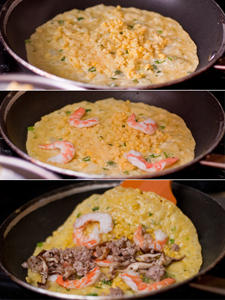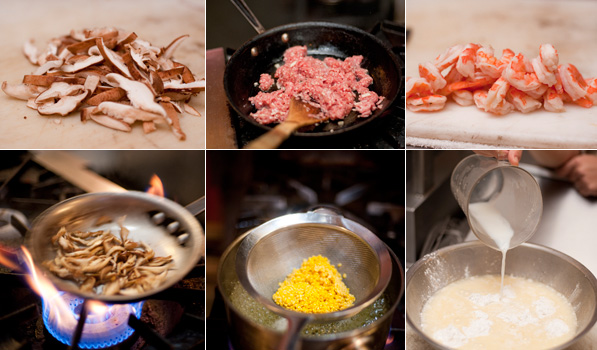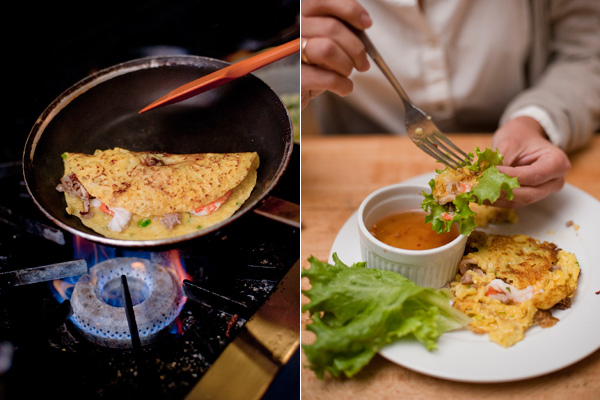
Pour, swirl, flip. Pour, swirl, flip. It’s all the same, redundant motion, whether you’re making Swedish pancakes, roti, or crepes. Vietnamese banh xeo (pronounced BAHN-seo) belong to that same genus of flat, pan-fried comfort foods.
For some reason, banh xeo have never really taken off among local fans of Vietnamese cuisine. No one ever seems to get into arguments about it, as the pho acolytes tend to do. Perhaps it’s the dish’s ever-shifting nomenclature that keeps it obscure: We’ve seen it referred to as a Vietnamese crepe, pancake, omelet, or taco, depending on the restaurant. With its crackly, yellow outside and pungent, savory filling, it’s a world apart from the noodle dishes that dominate the scene.

Banh xeo differ from crepes in several key ways: They’re gluten-, dairy-, and egg-free; and they’re fried to a much crispier finish. Pantry-wise, all you need for the batter is rice flour, turmeric, coconut milk, and water. You can purchase a packaged dry mix of the ingredients from any Vietnamese grocery store.
The traditional Southern Vietnamese fillings include roast pork, shrimp, bean sprouts, steamed mung beans, and fried onion. Most restaurants in Minneapolis and St. Paul serve it that way, with the noted exception of the Asian fusionistas at Ngon Bistro, who serve it with scallops and mango chutney.
Newbies will probably require some instruction before digging in. First, tear off a hefty piece of the cake with your chopsticks. Place it on a lettuce leaf and add your preferred herbs and pickles. Wrap it securely and dip it into ngoc cham, a jazzed-up dipping sauce made with fish sauce, lime, sugar, and water. And finally, stuff it into your mouth! You will undoubtedly experience a few Chipotle-style overstuffing moments before you figure out the ideal banh xeo-to-lettuce ratio.
To try a professional take on the dish, we checked out Hien Deli‘s version ($8). Still, there are many other versions out there; perhaps a Cities-wide survey is in order? Hien’s banh xeo was huge — about a foot in diameter — and looked promising. The batter was perfectly crispy, but the filling was greasy, bland, and surprisingly meager. We resolved to do them one better with our recipe.
Banh Xeo
Serves 4 as a light meal
1 package banh xeo mix, or 2 c rice flour and 1 tsp turmeric
1 can coconut milk
water
salt to taste
1 tsp sugar
1 bunch of green onions, thinly sliced
½ c dried mung beans, soaked overnight
1 shallot, minced
8 oz shiitake mushrooms, sliced
1 tbsp nuoc mam (fish sauce)
1 lb ground pork
½ lb shrimp, boiled, peeled, and halved lengthwise

- Combine first six ingredients in a large bowl. (Note: Add just enough water to give the batter the consistency of half-and-half.)
- Steam the mung beans until soft.
- Saute the shallot in oil. Once the pieces become transparent, add the shiitakes. Saute for a minute, then add the pork and nuoc mam. Continue to saute until pork is cooked through. Season with salt and pepper.
- Preheat a nonstick or crepe pan over low heat for 10minutes. Add oil. Using a ladle, pour just enough batter into the pan to cover the bottom. Immediately tilt the pan to coat.
- Add your preferred ratio of filling ingredients — mung bean, pork, shrimp — to the batter and fold.
- Serve with Thai basil, cilantro, lettuce leaves, ngoc cham, and pickled vegetables.

